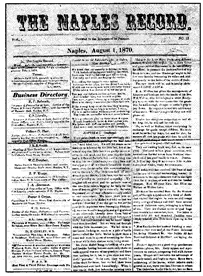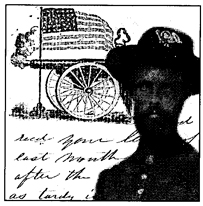DID YOU SEE?
ARTICLES
The Naples Record Wednesday, November 3, 2010
Digitizing the past
Naples Library to offer digital archives of local historical materials
by Amy Vangellow
The Naples Record
|
Accessing the past is about to become a whole lot easier for anyone interested learning about the history of the Naples community. The Naples Library is poised to become the first in the Pioneer Library System to offer digital archives of local historical materials like early issues of the Naples Record, Civil War letters and Naples School Board and Rotary records.
Naples Library Manager Blanche Warner says many of these documents have only been available on microfilms produced during the 1970s. Within the next couple of weeks, visitors to the Naples Library homepage (naples.pls-net.org) will be able to link to the digital archives with a click of a button titled "Naples Local History," and view documents that chronicle much of Naples history since the late 1800s.
Warner says that the Naples Library began the project last February. A phone call to Ed Varno of the Ontario County Historical Society led Warner to document management and archival specialists at the NanoArk Corporation in Rochester.
NanoArk Corporation was incorporated in 2007 and currently has offices in Rochester and Bangalore, India, where they specialize in conserving and archiving documents using a proprietary technology known as Waferfiche. NanoArk Corporation clients include libraries, museums, government agencies, schools and institutions.
|
"The Naples Library is a local institution that is way ahead of the curve in adopting technology. They didn't know the technology, but they knew exactly what they wanted," said NanoArk Vice President of Technology, Dr. Ajay Pasupuleti.
According to Warner, The Naples Library received funding from the Naples Historical Society to undertake the digital preservation project. Issues of the Naples Record dating back to 1870, Civil War letters and enrollments, school board and Rotary records and student research papers will all be available electronically through an Almirah document management system installed on a server at the library. The Almirah system will allow internet users to search documents by type and date and view images of the actual documents. Warner dis-cussed that some of the original documents, like the Civil War letters, were difficult to read due to age, but technology will allow viewers to see an enhanced image that is much clearer.
Dr.Pasupuleti explained the process that NanoArk Corporation used to help the library meet its archival goals.
"First we digitize the documents. Due to age, they can't be put through a regular scanner. Then we take the digital images and enhance them. Next the documents are indexed and we make them available to the public."
The last step he says is preserving the documents using Waferfiche technology, which he describes as "a new media for long-term storage solutions. It is very stable, like etching in stone."
The NanoArk Corporation website discusses some of the drawbacks to saving documents using traditional microfilm technology: "IT leaders and archivists have warned of the risks of storing document-based knowledge in formats that are at risk to deteriorate. In recent years, the world has lost significant works of knowledge due to the impermanence of storage media and technology. Paper, the most commonly used document medium, is highly vulnerable to forces of nature. In recent years, archivists and publishers have turned to microfilm technology, a black-and-white photographic process that places images onto reels or sheets of film. These images can then be read using special magnifying readers. However, this medium is also vulnerable to physical damage, and must be stored in carefully climate-controlled, limited access facilities in order to achieve its maximum life expectancy. As a result, many images stored in this fashion are now in poor condition and incapable of being read." With the emerging Waferfiche technology, "the data from print, digital or any other media is converted to images. Using photolithography tools and fabrication techniques, these images are then imprinted and etched on silicon wafers."
Dr. Pasupuleti said "the Waferfiche silicon wafer can be subjected to fire or water with no loss of data. The life expectancy of Waferfiche is 500 years, and it doesn't require expensive climactic conditions."
Warner discussed the library's plans for future use of the Waferfiche technology to preserve historical documents. "That is a possibility - it's very expensive and we would need a grant for that. We're looking into it."
Pasupuleti commended the Naples Library for its commitment "to use technology to preserve information." He commented that his favorite documents included in the library collections are the Civil War letters written between husband and wife.
"It is quite rewarding to help make Naples' history available to the world," he said.

 Naples Records dating from the 1870s will be available on-line
Naples Records dating from the 1870s will be available on-line Civil War letters have been digitized and will be available on-line at the Naples Library web site
Civil War letters have been digitized and will be available on-line at the Naples Library web site